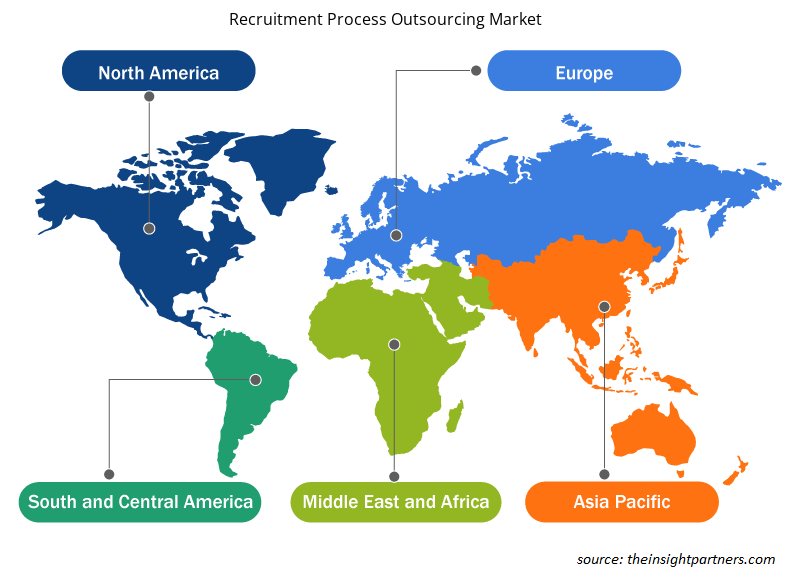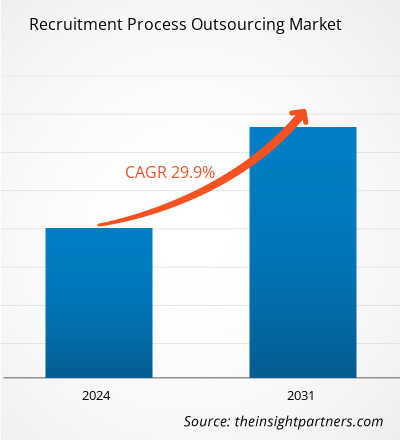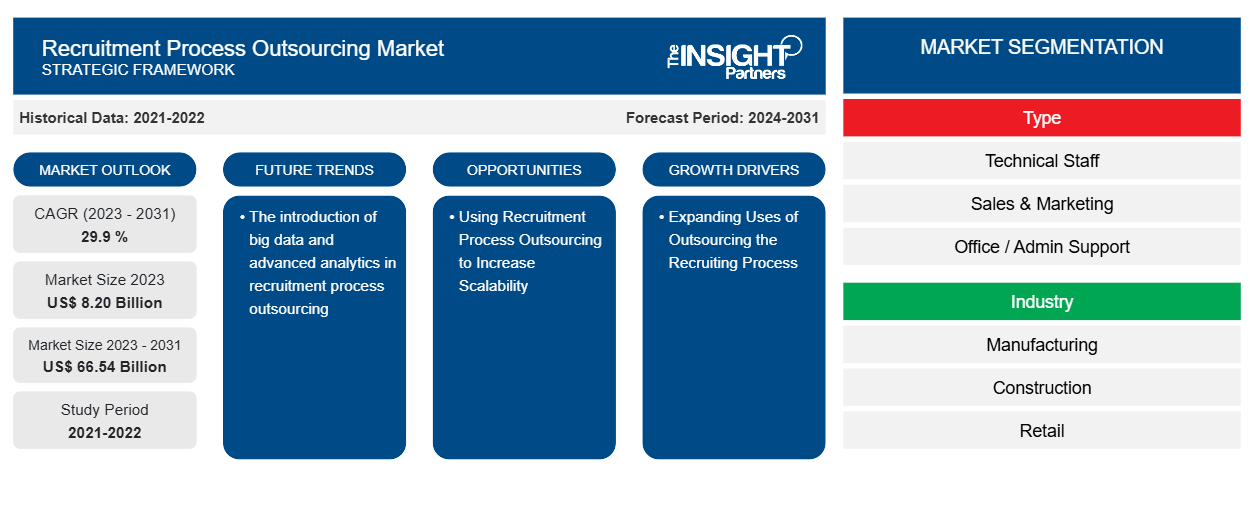Le marché de l’externalisation des processus de recrutement devrait atteindre 66,54 milliards USD d’ici 2031, contre 8,20 milliards USD en 2023. Le marché devrait enregistrer un TCAC de 29,9 % en 2023-2031. La demande croissante de processus de recrutement rationalisés et de nouvelles approches d’embauche a stimulé le potentiel de croissance du marché de l’externalisation des processus de recrutement (RPO).
Analyse du marché de l'externalisation des processus de recrutement
Les fournisseurs de services d'externalisation du processus de recrutement (RPO) comptent sur l'adoption de la technologie et l'intégration des médias sociaux pour proposer un sourcing de talents plus innovant. Les principales organisations de RPO ont déjà adopté le big data, le cloud, le SaaS et les technologies mobiles. L'utilisation de systèmes de suivi des candidats (ATS), la sélection informatisée des CV par mots-clés et l'auto-programmation des entretiens contribuent tous à accroître la qualité des candidats tout en maîtrisant les coûts. En conséquence, les fournisseurs de RPO se concentrent sur des tactiques axées sur la technologie, généralement en coopérant avec les fournisseurs de technologie et en développant leurs solutions. La demande d'une procédure d'embauche efficace et de frais généraux réduits sont les deux principales raisons qui propulsent la croissance du marché.
Aperçu du marché de l'externalisation des processus de recrutement
Les prestataires de services d’externalisation du processus de recrutement (RPO) s’occupent de diverses tâches, notamment de la recherche et de la sélection des candidats et du maintien de la qualité du recrutement. Afin d’améliorer leurs capacités, les prestataires de services mettent en pratique des technologies de pointe telles que l’intelligence artificielle (IA) et l’apprentissage automatique (ML) pour automatiser la sélection des CV et l’auto-programmation des entretiens. Les prestataires de services facilitent encore davantage la participation des candidats en utilisant des chatbots et d’autres outils d’évaluation. L’intelligence artificielle devrait révolutionner le secteur de l’emploi. Pour améliorer la planification stratégique du personnel, elle automatise les processus liés à la recherche de candidats, à la redécouverte, aux références des employés et au recrutement de la diversité.
Personnalisez ce rapport en fonction de vos besoins
Vous bénéficierez d'une personnalisation gratuite de n'importe quel rapport, y compris de certaines parties de ce rapport, d'une analyse au niveau des pays, d'un pack de données Excel, ainsi que de superbes offres et réductions pour les start-ups et les universités.
- Obtenez les principales tendances clés du marché de ce rapport.Cet échantillon GRATUIT comprendra une analyse de données, allant des tendances du marché aux estimations et prévisions.
Facteurs moteurs et opportunités du marché de l'externalisation des processus de recrutement
L'externalisation du processus de recrutement se développe pour favoriser le marché
L'externalisation du processus de recrutement (RPO) est nécessaire pour générer une valeur ajoutée continue pour l'entreprise tout en minimisant les coûts d'exploitation autant que possible. Par conséquent, les entreprises ont de plus en plus recours à des services RPO pour réduire le coût de l'emploi. Lorsqu'une entreprise se développe dans une nouvelle catégorie de produits ou dans une nouvelle région du monde, le recrutement doit augmenter considérablement. De même, en cas de crise économique, des licenciements sont nécessaires. De telles disparités sont coûteuses pour toute entreprise. Pour résoudre ces disparités du marché, les partenaires RPO accélèrent le processus de recrutement.
Utiliser l'externalisation du processus de recrutement pour augmenter l'évolutivité
Les entreprises se concentrent sur un processus de recrutement efficace en termes de temps. Il se compose de plusieurs étapes, commençant par une sélection initiale et progressant à travers de nombreux cycles d'évaluation et de vérification des antécédents. Le personnel des RH n'est pas en mesure de suivre les tendances du secteur ; par conséquent, le processus de recrutement est externalisé à des fournisseurs RPO qui utilisent des plateformes technologiques. Ces plateformes en ligne permettent de gagner environ 40 % de temps de recrutement. Les entreprises ont créé un processus de sélection efficace qui promeut la marque tout en réduisant le temps de recrutement en utilisant l'IA, les entretiens vidéo et la méthodologie de sélection.
Analyse de segmentation du rapport sur le marché de l'externalisation des processus de recrutement
Les segments clés qui ont contribué à l’élaboration de l’analyse du marché de l’externalisation du processus de recrutement sont le type et le secteur d’activité.
- En fonction du type, le marché de l'externalisation du processus de recrutement est segmenté en personnel technique, ventes et marketing, support bureautique/administratif et autres.
- En termes d'industrie, le marché est segmenté en fabrication, construction, vente au détail, informatique, hôtellerie, BFSI, pétrole et gaz, télécommunications et autres.
Analyse des parts de marché de l'externalisation des processus de recrutement par zone géographique
La portée géographique du rapport sur le marché de l'externalisation du processus de recrutement est principalement divisée en cinq régions : Amérique du Nord, Asie-Pacifique, Europe, Moyen-Orient et Afrique, et Amérique du Sud/Amérique du Sud et centrale. L'économie américaine revient à la normale, avec des taux d'emploi plus élevés, une demande croissante de diplômes d'enseignement supérieur et une mise à niveau des compétences dans de nouveaux domaines. Les secteurs de la fabrication et de la santé, les soins de santé étant l'un de ceux qui connaissent la plus forte croissance, créent de nouvelles possibilités d'emploi dans tout le pays. Plusieurs initiatives gouvernementales et conditions favorables ont contribué à revitaliser le secteur industriel aux États-Unis, créant de nouveaux emplois.
Aperçu régional du marché de l'externalisation des processus de recrutement
Les tendances et facteurs régionaux influençant le marché de l’externalisation des processus de recrutement tout au long de la période de prévision ont été expliqués en détail par les analystes d’Insight Partners. Cette section traite également des segments et de la géographie du marché de l’externalisation des processus de recrutement en Amérique du Nord, en Europe, en Asie-Pacifique, au Moyen-Orient et en Afrique, ainsi qu’en Amérique du Sud et en Amérique centrale.

- Obtenez les données régionales spécifiques au marché de l'externalisation des processus de recrutement
Portée du rapport sur le marché de l'externalisation des processus de recrutement
| Attribut de rapport | Détails |
|---|---|
| Taille du marché en 2023 | 8,20 milliards de dollars américains |
| Taille du marché d'ici 2031 | 66,54 milliards de dollars américains |
| Taux de croissance annuel composé mondial (2023-2031) | 29,9 % |
| Données historiques | 2021-2022 |
| Période de prévision | 2024-2031 |
| Segments couverts | Par type
|
| Régions et pays couverts | Amérique du Nord
|
| Leaders du marché et profils d'entreprises clés |
|
Densité des acteurs du marché de l'externalisation des processus de recrutement : comprendre son impact sur la dynamique des entreprises
Le marché de l'externalisation du processus de recrutement connaît une croissance rapide, tirée par la demande croissante des utilisateurs finaux en raison de facteurs tels que l'évolution des préférences des consommateurs, les avancées technologiques et une plus grande sensibilisation aux avantages du produit. À mesure que la demande augmente, les entreprises élargissent leurs offres, innovent pour répondre aux besoins des consommateurs et capitalisent sur les tendances émergentes, ce qui alimente davantage la croissance du marché.
La densité des acteurs du marché fait référence à la répartition des entreprises ou des sociétés opérant sur un marché ou un secteur particulier. Elle indique le nombre de concurrents (acteurs du marché) présents sur un marché donné par rapport à sa taille ou à sa valeur marchande totale.
Les principales entreprises opérant sur le marché de l'externalisation des processus de recrutement sont :
- RPO à sept étapes
- Conseil en cerfs-volants
- Randstad Sourceright
- Solutions ManpowerGroup
- Alexandre Mann
- Recrutement Adam
Avis de non-responsabilité : les sociétés répertoriées ci-dessus ne sont pas classées dans un ordre particulier.

- Obtenez un aperçu des principaux acteurs du marché de l'externalisation des processus de recrutement
Actualités et développements récents du marché de l'externalisation des processus de recrutement
Le marché de l'externalisation du processus de recrutement est évalué en collectant des données qualitatives et quantitatives après des recherches primaires et secondaires, qui comprennent des publications d'entreprise importantes, des données d'associations et des bases de données. Voici une liste des évolutions du marché :
- En août 2022, Hudson Global, Inc., une société de conseil en gestion, a acheté Hunt & Badge, une société de recrutement basée à Chennai. Cette acquisition vise à renforcer le personnel de l'entreprise et à étendre ses opérations à d'autres secteurs d'activité à travers le monde.
(Source : Hudson Global, site Web de l'entreprise, 2022)
- En mai 2021, TrackTik Software, spécialiste de la gestion des effectifs de sécurité basée sur le cloud, a annoncé un partenariat avec ADP Workforce Now, un système complet de gestion de la paie et des RH. Cette collaboration vise à rationaliser le processus de paie en éliminant le besoin de saisie humaine des données, ce qui entraîne une réduction des dépenses, moins d'erreurs et un gain de temps plus important.
(Source : TrackTik Software, site Web de l'entreprise, 2023)
Rapport sur le marché de l'externalisation des processus de recrutement : couverture et livrables
Le rapport « Taille et prévisions du marché de l'externalisation des processus de recrutement (2021-2031) » fournit une analyse détaillée du marché couvrant les domaines ci-dessous :
- Taille du marché et prévisions aux niveaux mondial, régional et national pour tous les segments de marché clés couverts par le périmètre
- Dynamique du marché, comme les facteurs moteurs, les contraintes et les opportunités clés
- Principales tendances futures
- Analyse détaillée des cinq forces de PEST/Porter et SWOT
- Analyse du marché mondial et régional couvrant les principales tendances du marché, les principaux acteurs, les réglementations et les développements récents du marché
- Analyse du paysage industriel et de la concurrence couvrant la concentration du marché, l'analyse de la carte thermique, les principaux acteurs et les développements récents
- Profils d'entreprise détaillés
- Analyse historique (2 ans), année de base, prévision (7 ans) avec TCAC
- Analyse PEST et SWOT
- Taille du marché Valeur / Volume - Mondial, Régional, Pays
- Industrie et paysage concurrentiel
- Ensemble de données Excel
Rapports récents
Témoignages
Raison d'acheter
- Prise de décision éclairée
- Compréhension de la dynamique du marché
- Analyse concurrentielle
- Connaissances clients
- Prévisions de marché
- Atténuation des risques
- Planification stratégique
- Justification des investissements
- Identification des marchés émergents
- Amélioration des stratégies marketing
- Amélioration de l'efficacité opérationnelle
- Alignement sur les tendances réglementaires





















 Obtenez un échantillon gratuit pour - Marché de l'externalisation des processus de recrutement
Obtenez un échantillon gratuit pour - Marché de l'externalisation des processus de recrutement